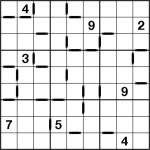Stepping up – Three-away Sudoku!
In a possibly inevitable next move (although in this case, I think, a probable conclusion to the theme rather than a stepping stone!) I thought I’d try out Three-away Sudoku, where black markers indicate all neighbouring squares with a difference of 3. With a 9×9 puzzle this still allows somewhat interesting 1-4-7, 2-5-8 and 3-6-9 chains to be used, although of course as you decrease the quantity of numbers that can fit in a chain so you start to lose the longer connected chains which I personally find so interesting.
Other than the three-away markers this is a regular 9×9 Sudoku puzzle, so just place 1 to 9 into each row, column and 3×3 box. Squares with a thick black bar between have a difference of 3 (e.g. 1&4), and those without a thick black bar between have a difference which is not 3.
An idea I have in mind to try next is to mix consecutive and two-away Sudoku in the same grid – I think any other combinations would be too confusing to play, although I suppose you could insert small numbers between squares to show selected differences which might make an interesting but possibly too mechanical variant. For me, I don’t want to have to stop and think about the rules I’m applying – in a good puzzle they should become intuitive really quickly (even if, in some cases, they are a little complex to learn they must become second nature for the puzzle to succeed – or so I find!).
Good luck! ![]()
Comments are closed.


about 16 years ago
I enjoyed this one. It was clever, but also more of the same. 3-away is more plain than odd/even 2-away or consecutive.
Having one with all 3 consecutive types in combination could be fun, but wouldn’t that break the negation logic? Still, it would be like playing a Killer Sudoku or CalcuDoku. I look forward to trying it out.
about 16 years ago
Yes, I agree that three-away is less interesting.
In terms of combinations, I suppose the way the negation logic would work would simply be that if there was no bar between two squares then the difference would not be 1 or 2 (or 3, if using three types of bar). The danger is it might be a bit confusing to keep track of/check whilst solving, however!
The danger is it might be a bit confusing to keep track of/check whilst solving, however!
about 16 years ago
I also enjoyed this one, but not as much as the two away ones – probably because the three away rule meant it was much easier to sort out the chains as there were less possibles.
It will be interesting to see what combination you come up with next!